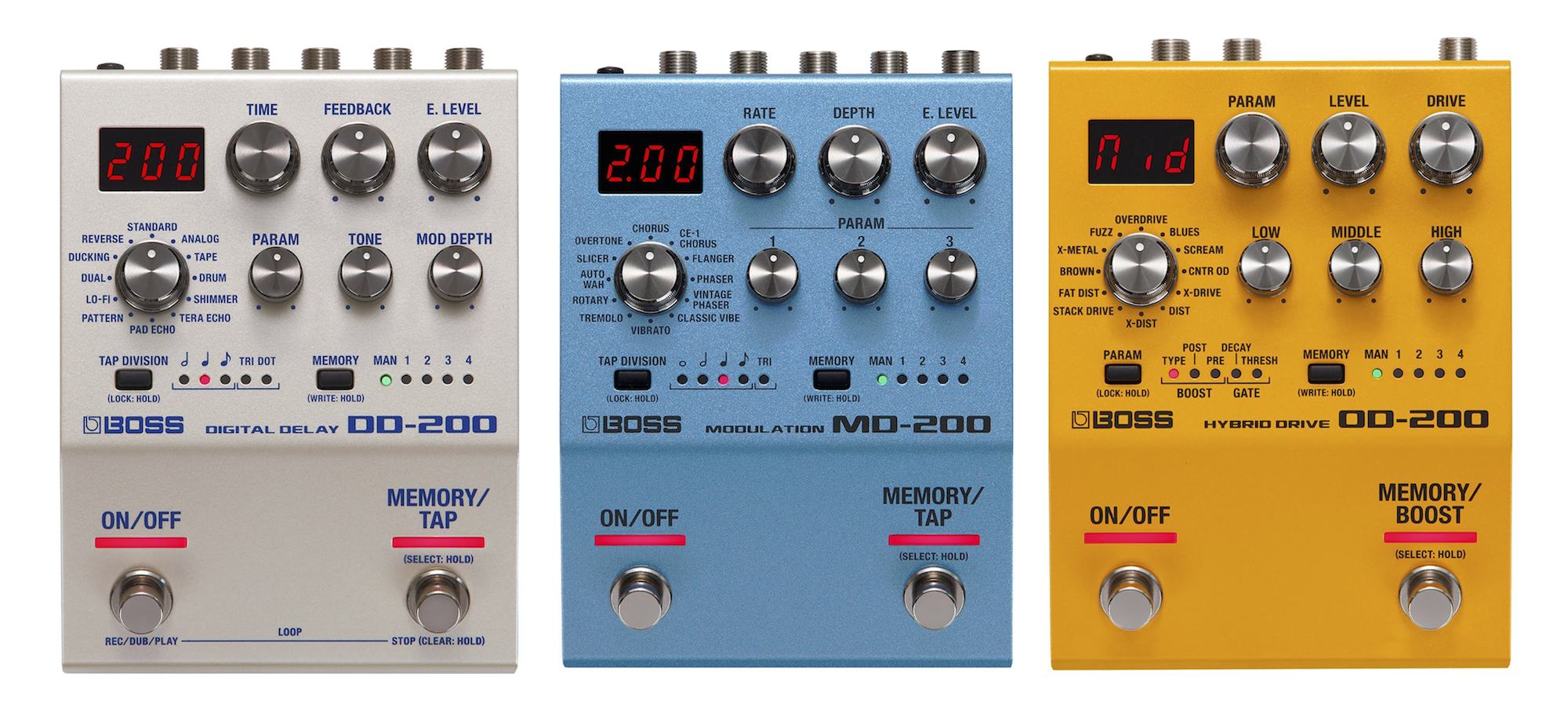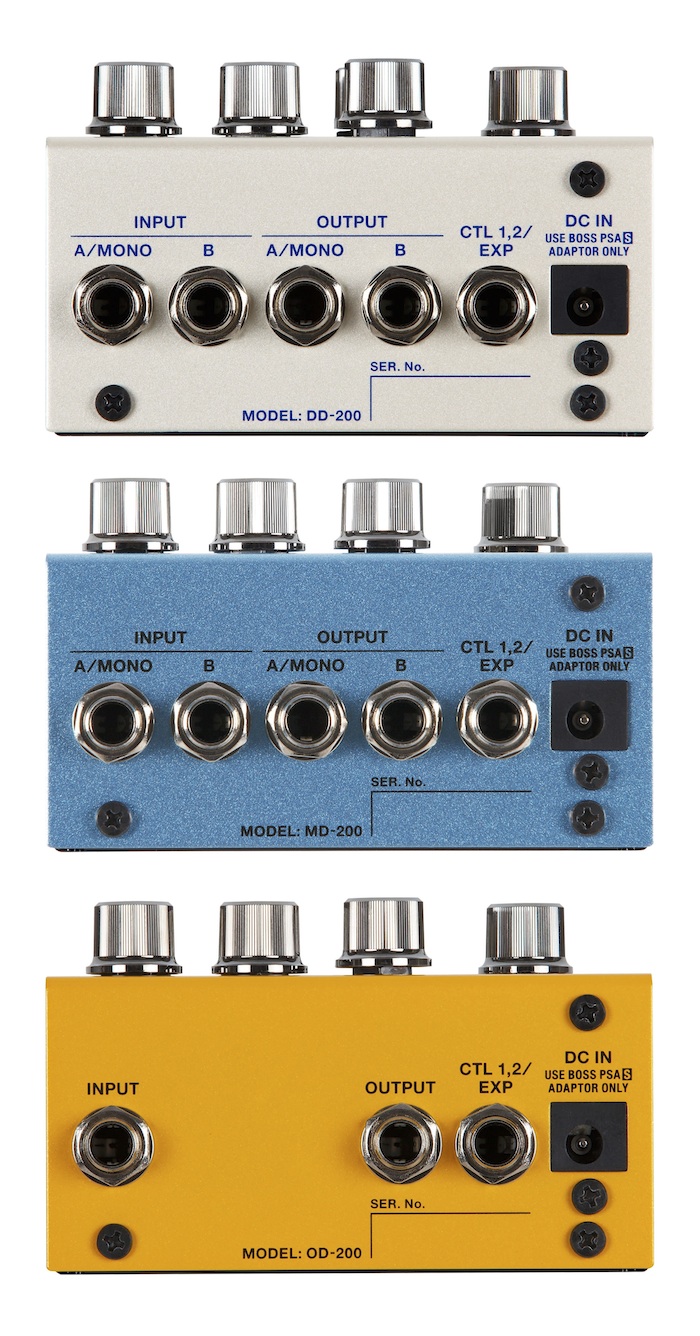New Gear Review: 200 Series Pedals by BOSS

Can BOSS’ new and improved 200 Series pedals find their respective places in your pedalboard? Let’s look at the DD-200, MD-200, and OD-200 to start.
BOSS has been a ubiquitous name in the pedal world for many years now, as their single-function stomp boxes are as iconic as the riffs they have produced. If you’ve ever played a four or six string instrument through an amp, there’s a good chance your signal was going through a BOSS pedal.
BOSS’ 500 Series of pedals expanded the designs of their single unit pedals into more fully-featured effects boxes, at the expense of greater space on your pedalboard. Last year, BOSS introduced the new 200 Series of pedals (derived from the sound engine of the 500 Series, but in a smaller enclosure), which replaces the old 20 Series with greater processing power.
This review covers three models in the new 200 Series line: the DD-200 Digital Delay, MD-200 Modulation, and OD-200 Hybrid Drive. There is also an EQ-200, which packs a programmable stereo/dual mono graphic equalizer into the same pedal format.
Let’s see how this trio of 200 Series pedals fares, and what they can tell us about the series as a whole.
Features
The BOSS 200 Series pedals come in seemingly-indestructible metal cases, so you’ll have no problem throwing them onto your pedalboard. The input and output jacks are located on the back of the pedals (mono in/out on the OD-200, stereo on the DD-200 and MD-200). There’s also an input jack for external footswitches, which can be used to scroll through presets or tap in tempo information. Each pedal can be powered via a BOSS or standard 9V power supply (not included), or three AA batteries, which are included. Each of the 200 Series pedals feature 32-bit AD/DA, a 32-bit floating point processor, with a 96kHz sampling rate.
Conveniently, the front of the 200 Series pedals slope downward slightly, making it easier to access the two footswitches, which have bright, easy-to-see light indicators. The right footswitch serves to cycle through the presets for each, while the left footswitch turns on and off the effect. The right footswitch also has secondary functions that are context dependent. On the OD-200, it activates an additional Boost circuit (more on this later).
On both the MD-200 and the DD-200, the second footswitch can also act as a tap tempo input, while the DD-200 sports even more functionality hidden within. Step on both footswitches at once and you enter into a Phrase Loop mode, which will be familiar to anyone who has used a BOSS looping pedal. The DD-200 can store up to 60 seconds and comes with the usual Record, Overdub, and Play modes.
Each pedal also features MIDI in/out ports on 1/8” jacks, though the pedals don’t come with adapters. A standard 1/8” TRS male to male cable can connect between all the 200 Series pedals, and BOSS also sells an 1/8” to 5-pin Din MIDI cable called the BMIDI-5-35. These allow you to get way more in-depth with the controls for each pedal inside of your DAW or using a MIDI controller. There are also micro USB ports on each pedal, though unfortunately these have been relegated to firmware updates only.
There are six knobs plus a mode encoder on each pedal; five of these knobs are smooth-turning, while the knob in the upper left-most corner has indentation. That knob can also be pushed and turned, which provides a way to change values more quickly. The OD-200 features a full three-band tone circuit, as well as controls for Drive, Level, and a context-based Parameter knob. The MD-200, meanwhile, features common modulation-focused knobs including Rate, Depth, and Effect Level, as well as three Parameter knobs that are specific to the mode you are in. The DD-200, meanwhile, sports all the controls you’d expect on a delay pedal—Time, Feedback, Effect Level, Tone, Mod Depth, and a mode-dependent Parameter knob.
In Use
Diving into each pedal showed just how many sounds were accessible. As mentioned, each of the BOSS 200 Series pedals feature the ability to store four presets or work in Manual mode. You are able to select presets via a button on the front panel of each pedal, as well as the right footswitch, and writing a preset is as simple as a long press of the same button. You can also store up to 99 presets and access them via MIDI.
Each pedal in the 200 Series comes with a dozen modes to choose from. The OD-200 Hybrid Drive is unique in that it features both analog and digital clipping circuits, hence the “Hybrid” in its name. The OD-200 features both a main distortion circuit and an additional Boost circuit; these can be used in series or parallel, greatly enhancing the sounds available. There’s a very flexible noise gate as well, with adjustable Decay and Threshold settings.
Several of the twelve modes on the OD-200 greatly impressed me and reminded me of boutique distortion pedals that almost always come with boutique prices. Those that were most impressive were the ”Cntr OD” (modeled after a Klon Centaur), the ”Brown” mode (modeled after a high-gain British lead sound), and the ”Scream” mode, which as you probably can guess, is based on the famed Tube Screamer.
There are an additional fifteen options (!) for different Boost modes, and every core pedal tone can also be a boost pedal—so using say, a Tube Screamer, to boost the input of your fuzz is totally possible. The fact that these two circuits can be combined in either series or parallel makes the amount of sounds possible from the OD-200 very plentiful. Digital-based drive pedals can be hit or miss, but the OD-200 really delivered in tones.

A closer look at the available connections on the BOSS 200 Series delay, modulation, and overdrive offerings.
Meanwhile, the DD-200 will likely please users of both BOSS’ DD-7 and Tera Echo pedals, as it features all of the sounds of those units and more, including settings for Drum, Shimmer, Lo-Fi, Reverse, and more typical delay settings like Tape, Reverse, and Standard, which is a crisp digital delay. As mentioned, tap tempo can be inputted via the second footswitch, and the time division can be changed via a button on the front of the pedal.
I found the range and depth of delays in the DD-200 nearly infinite, as it really can seemingly do any delay sound you can imagine. I found the Drum and Pattern modes particularly pleasing, as each has qualities similar to a Binson Echorec. The looper functionality works as you’d expect and sounds crystal clear, and luckily you can still use the delay engine simultaneously.
Similar to the Electro-Harmonix Mod11 that I reviewed not long ago, the MD-200 aims to cover all your modulation bases. There’s a lot of crossover with the Mod11, as each features Chorus, Tremolo, Vibrato, Flanger, Phaser, and more. The MD-200 has quite a bit more hands-on control, as there are three Parameter knobs that change function based on mode. Moreover, the Rate knob can alternate between Hz and BPM with a push—a useful touch that makes the MD-200 easy to integrate into electronic rigs.
Several of the effects in the MD-200 have secondary settings built-in (not unlike the Mod11, yet again). The Display uses a fair amount of abbreviations to note these parameters, so keeping the manual nearby might be useful. The sounds overall are sure to inspire, as they are very thick and lush, particularly the “CE-1 Chorus” and “Vibrato” settings.
One of the most useful features of the MD-200 is its ability to set the modulation effect before or after another pedal that is plugged into a built-in “insert” loop that takes advantage of the stereo in/out jacks. This selection is also stored with each preset, allowing you to customize where in the chain your modulation fits without tearing up your pedalboard cabling—very handy.
The MIDI functionality of all the 200 Series pedals greatly increases what is possible, as it allows you to re-assign footswitch settings, recall memory presets from up to 127 locations, and more. It’s also possible to MIDI-chain several of the 200 Series pedals and change presets on them simultaneously, making them effectively function like one super-flexible multi-effects pedal.
To Be Critical
There wasn’t a lot I found at fault with the BOSS 200 Series pedals, as they pack a lot of functionality into a fairly small footprint. I did find that the footswitches aren’t the easiest to click down; soft-click footswitches would have been appreciated here.
Summing it Up
As mentioned, there’s a lot to love about all three of these pedals; a lot of great sounds can be found within. The OD-200 impressed most of all with its useful and plentiful organic-driven tones, though the MD-200 and OD-200 were no slouches either. The versatility of these pedals is their greatest strength, as each can take on several functions in your setup.
The fact that they don’t take up much pedalboard real estate, can store presets, and have a lot of connectivity options, makes these three BOSS 200 Series pedals easy to recommend. Plus, who doesn’t love a matching set?
Leo Maymind is a producer, DJ, and writer living in Los Angeles, CA. He is obsessed with sound, and you can reach him at lmaymind@gmail.com.
Please note: When you buy products through links on this page, we may earn an affiliate commission.







[…] BOSS has been a ubiquitous name in the pedal world for many years now, as their single-function stomp boxes are as iconic as the riffs they have produced. If you’ve ever played a four or six string instrument through an amp, there’s a good chance your signal was going through Read more… […]